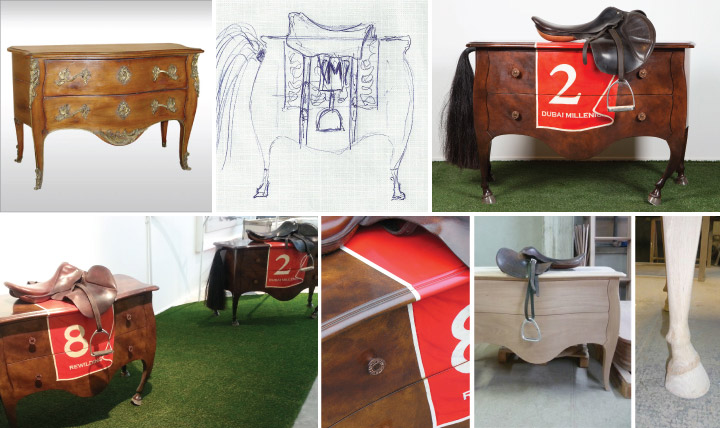Headless Horses
2013 – Dubai, UAE
In early October 2012, Khalid Shafar was commissioned by the famous French furniture manufacturer, Moissonnier, to reinterpret one of their iconic chests as a limited edition work for Design Days Dubai in March 2013. This presented Khalid with the interesting challenge of creating a classic piece in a fresh new way that would respect the history of the piece, yet give it a new perspective for today’s trends. In his design process, he had to consider the Moissonnier brand ethos, the art of painting, sculpture and producing exceptional items of French traditional cabinetmaking, at the same time asserting a local connection and his own KHALID SHAFAR brand aesthetic.
On seeing the chest shape in shades of brown Khalid was immediately reminded of the shape of a horse’s body and Dali’s famous drawings and sculpture of an elephant with long skinny legs. From there, he searched for links with his own roots and found them in ‘Dubai World Cup’ the richest horse race in the world. Over the years the race has been won by many great Arabian horses and this provided the perfect link between Moissonnier and the Middle East.
Khalid’s design transformed two Moissonnier chests into pieces of art – sculptures that tell the story of two legendary horses that were victorious in the Dubai World Cup. Dubai Millennium which won in 2000 and Rewilding which won in 2011 were both from Godolphin, Dubai’s Al Maktoum Royal Family private horseracing stable. The dramatic aspect of this story is that both these remarkable horses died prematurely and tragically. Hence, the name ‘Headless Horses’.
Each chest represents one of the horses. The highly skilled craftsmen of Moissonnier were very careful to match the patina of the actual horse’s body colour and shades exactly – a difficult task when they only had old photos as reference. Vintage leather saddles were needed along with horsetails and the team at Moissonnier acquired these from a reputable French saddle maker to complete the pieces.
Headless Horses achieved this collaboration’s objective by presenting to both brands’ customers a fresh new work with a unique perspective. For Moissonnier, this tragic yet powerful conceptual work was a window for their brand to look at more collaborations in future with designers of different backgrounds and cultures. Whereas, for the KHALID SHAFAR brand, this was another high profile collaboration and a challenge to work with objects belonging to totally different eras and styles.


